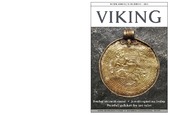| dc.contributor.author | Nordeide, Sæbjørg Walaker | |
| dc.date.accessioned | 2015-12-11T09:53:23Z | |
| dc.date.available | 2015-12-11T09:53:23Z | |
| dc.date.issued | 2015 | |
| dc.identifier.issn | 0332-608x | |
| dc.identifier.uri | https://hdl.handle.net/1956/10743 | |
| dc.description.abstract | Viking Age art is dominated by animal motifs. In particular, the so-called ‘gripping-beasts’ spread from the end of the eighth century. This article discusses a couple of examples of motifs on archaeological objects in which people and animals are combined, namely from Oseberg and Lærdal. On the basis of the examples, the mythological meaning of the gripping-beast style is discussed. By combining archaeological and written sources, it is suggested that the animal style may well be inspired by foreign impulses, for instance religious, Christian art, but the particular Scandinavian development of the gripping-beast style fits well with the assumed cosmology in late Iron Age in Scandinavia. Several aspects indicate that the gripping-beasts’ significance may be anticipated to be associated with religious ideas in what we roughly may call Old Norse religion, and the art applied may have contributed to the spread and maintenance of myths and important events as well as social ideology accordingly. | en_US |
| dc.language.iso | nob | eng |
| dc.publisher | Norsk Arkeologisk Selskap | eng |
| dc.subject | Archaeology | eng |
| dc.subject | Viking Age | eng |
| dc.subject | Viking Age Style | eng |
| dc.subject | Scandinavia | eng |
| dc.title | Scener fra vikingtid som kilde til kosmologi | eng |
| dc.type | Peer reviewed | en_US |
| dc.type | Journal article | en_US |
| dc.description.version | publishedVersion | |
| dc.rights.holder | Copyright Norsk Arkeologisk Selskap | eng |
| dc.source.journal | Viking | |
| dc.source.40 | LXXVIII | |
| dc.source.pagenumber | 207-219 | |
| dc.subject.nsi | VDP::Humaniora: 000::Arkeologi: 090::Nordisk arkeologi: 091 | nob |
